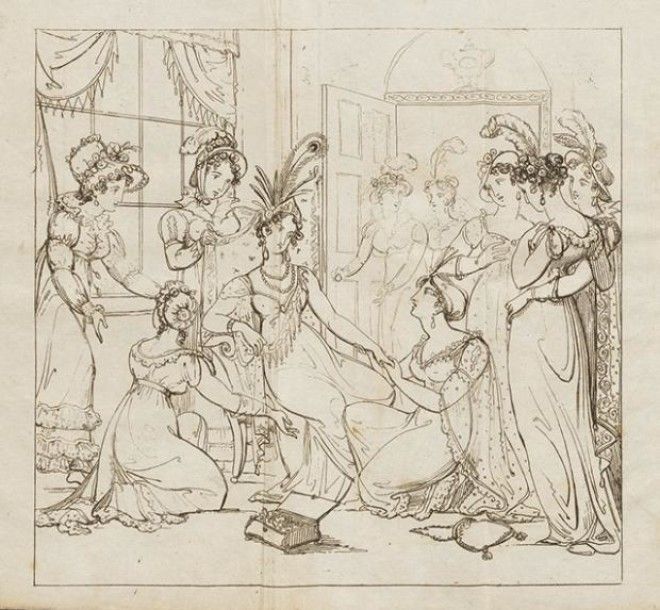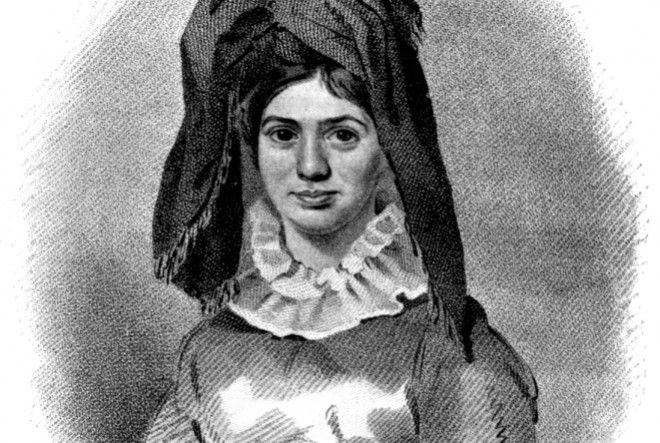Dressed in a shabby black gown and shawl with a turban on her head, she seemed confused and utterly exhausted, as if she had just completed a long journey. Under her arm, she carried a small bundle of belongings, including a bar of soap and some basic toiletries wrapped in a piece of linen. Most curiously of all, she spoke an exotic language no one in the village could understand.
The locals, understandably, were mystified.
Presuming that she was some kind of beggar, the villagers took the woman to the overseer of the local poorhouse. But instead of taking her in, the overseer—suspicious of foreign agents amid the tense climate following the Napoleonic Wars—turned her over to the local magistrate, Samuel Worrall, at his palatial country residence known as Knole House. The magistrate called upon his Greek valet, who had an extensive knowledge of many Mediterranean languages, to try to translate what the woman was saying, with no luck. When asked using a series of gestures to produce identification papers, the woman merely emptied a few coins from her pockets.
Worrall was suspicious, but his wife was empathetic, and clearly more fascinated than alarmed by the woman’s sudden appearance in the village. At Mrs. Worrall’s request, the mystery woman was sent to spend the night at the local inn—and once there, her behavior became even more erratic. She refused a meal and drank only tea, reciting a bizarre prayer beforehand while holding one hand over her eyes. She appeared to recognize a print of a pineapple hanging on the wall of the inn, giving the staff and locals the impression that she had traveled from some far-flung tropical land. And when the time came for her to be shown to her room for the night, she stared cluelessly at the bed before curling up on the floor to sleep instead.
After what must have been a perplexing night for the inn's staff, Mrs. Worrall brought the woman back to Knole House. By then, she had revealed—by pointing to herself and repeatedly uttering the word—that her name was "Caraboo." But Mr. Worrall was fed up: The woman was clearly nothing more than a beggar, he declared, and had her arrested on a charge of vagrancy. "Caraboo" spent several days in St. Peter’s Hospital for Vagrants in Bristol before Mrs. Worrall again stepped in and had her removed to Worrall’s offices. By then, news of Almondsbury’s unusual stranger had begun to spread, and dozens of curious locals were visiting the woman, each bringing speakers of an array of different languages. Despite numerous visitors during her 10-day stay, no one could decipher a single word she said.
Until, finally, someone did.

Upon hearing news of the mysterious woman, a Portuguese sailor named Manuel Eynesso, who happened to be in Bristol, dropped in at Worrall's offices to meet with her. Having traveled extensively in the Far East and the Dutch East Indies, Eynesso seemingly recognized Caraboo’s language as a mixture of native tongues from Sumatra, and immediately began to translate her extraordinary story.
Caraboo, Eynesso explained, was no beggar. She told him she was a princess from the Indian Ocean island of “Javasu" who had been kidnapped from her homeland by pirates and held captive before escaping by jumping overboard in the Bristol Channel. She had then wandered the countryside for six weeks before finding herself in Almondsbury.
It was quite the tale, and gave Mrs. Worrall all that she needed to hear: Caraboo was royalty, and it would be an honor to have her come to live at Knole House. For the next 10 weeks, grand parties and soirées were arranged in Caraboo's honor, and the princess was scrutinized by academics and fawned over by the highest of high society—they were amazed by the story of the penniless beggar who had turned out to be a foreign princess. A man named Dr. Wilkinson wrote a glowing account of her, noting, “Nothing has yet transpired to authorize the slightest suspicion of Caraboo.” But that was about to change.

Word of Princess Caraboo continued to spread in the press, and a description of her was printed a few weeks later in the Bristol Journal. A copy found its way to a boarding house run by a local lady named Mrs. Neale, who immediately recognized the woman—but not as a kidnapped Javanese princess. Mrs. Neale believed Caraboo was actually a former guest of hers named Mary Baker, a cobbler’s daughter from Witheridge, a village just 70 miles away. Princess Caraboo, Mrs. Neale said, was a hoax.
Messages were soon being relayed from house to house and town to town until word finally reached Mrs. Worrall. Initially skeptical of Mrs. Neale’s version of events, Mrs. Worrall made arrangements for “Princess Caraboo” to accompany her to Bristol under the pretense of having a portrait painted of her. Instead, Mrs. Worrall used the trip to meet with Mrs. Neale in person—and after a brief conversation, she was left in no doubt that “Princess Caraboo” was indeed an imposter. Following months of deception, the extraordinary ploy came crashing down and, once confronted by Mrs. Worrall, "Caraboo"—a.k.a. Baker—admitted everything, in tears.
Baker had been born in rural Devon in 1791. She had a falling out with her parents at a young age, and afterward worked a string of jobs across the south of England before ending up begging on the streets in and around Bristol in the early 1810s. It was there that she discovered that posing as a foreigner allowed her to elicit more sympathy (and therefore cash) from the public. After inventing the character of “Princess Caraboo”—along with her indecipherable language—to entertain the children at Mrs. Neale’s guesthouse, she applied her inventiveness to the extraordinary deception of Mrs. Worrall and the people of Almondsbury. There never was any "Javasu."
Once news of Baker’s hoax broke, the press were quick to pounce yet again—but rather than turn it against her, the majority of journalists spun the tale as an unlikely triumphing of the working classes over the aristocracy. Baker became an unlikely heroine: an ill-educated, downtrodden girl who, through her own quick-wittedness and unquestionable guts, had managed to infiltrate and deceive the highest of high society, thereby exposing their fickleness and vanity.
And even Mrs. Worrall came to appreciate Baker’s success.
Although initially angry, Mrs. Worrall soon came to view Baker’s real-life story with the same empathy and open-mindedness as she had the princess's tale. She resolved to continue to help Baker make a better life for herself, and raised funds for her to relocate to Philadelphia in 1817 to make a fresh start. Once in America, Baker managed to cash in on her notoriety and put on a short-lived stage show in New York based on her Princess Caraboo character. A few years later, she returned to England and staged the same show in London—but by then, the Caraboo craze had subsided and the show was only a marginal success.
Census records show that by the late 1820s, Baker (now a widow named Mary Burgess) was living back near Bristol, and making her living selling leeches to the local infirmary. She continued that vocation for 30 years, before dying of a heart attack in 1864—taking the mysterious character of “Princess Caraboo” with her. As for the "Portuguese sailor" who translated her story, it's not clear how he could have understood a made-up language—unless he, too, was an imposter.

